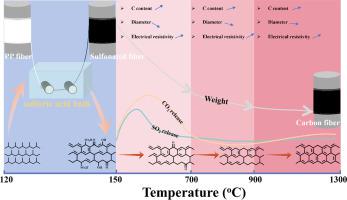当前位置:
X-MOL 学术
›
Polym. Degrad. Stabil.
›
论文详情
Our official English website, www.x-mol.net, welcomes your feedback! (Note: you will need to create a separate account there.)
Carbon fibers from polypropylene: Structural evolution of precursor fiber during stabilization and carbonization
Polymer Degradation and Stability ( IF 6.3 ) Pub Date : 2024-03-11 , DOI: 10.1016/j.polymdegradstab.2024.110736 Minghang Yang , Yu Deng , Qiongxia Liu , Cheng Liu , Jian Xu , Xigao Jian , Yousi Chen
Polymer Degradation and Stability ( IF 6.3 ) Pub Date : 2024-03-11 , DOI: 10.1016/j.polymdegradstab.2024.110736 Minghang Yang , Yu Deng , Qiongxia Liu , Cheng Liu , Jian Xu , Xigao Jian , Yousi Chen

|
Utilizing polypropylene (PP) fibers as the precursor material, Polypropylene-based carbon fibers (CFPP) were obtained by carbonization after sulfonation cross-linking with sulfuric acid. First, the mechanism of structural evolution of sulfonated PP fiber (SFPP) during carbonization was investigated at temperatures between 500 °C-1300 °C. According to the results, the chemical structure, as well as the carbon structure transformation of SFPP, depending on the carbonization temperature, i.e., the removal of organic functional groups, the fusion to small aromatic structures, and the transformation to ordered carbon structures. The carbon content of the carbon fibers obtained at 1300 °C was as high as 93.4 %. Subsequently, various PP fibers with different diameters and crystalline structures were prepared by melt spinning and subsequent thermal-drawing treatment, and the relationship between their structures and the properties of CFPPs was investigated. The sulfonation reaction rate of PP fibers increased as the sulfonation reaction proceeded and was synergistically regulated by the crystalline structure and fiber diameter. The CFPP with a smaller diameter exhibited a more homogeneous skin-core structure, together with higher overall graphitization, smaller graphite layer spacing, and better graphite microcrystalline structure, and thus its conductivity and mechanical properties of the carbon fiber were significantly improved. The mechanical properties and volume resistivity of the prepared CFPP reached 338.6 MPa and 4.91×10 Ω·m, respectively.
中文翻译:

聚丙烯碳纤维:稳定和碳化过程中前体纤维的结构演变
以聚丙烯(PP)纤维为前驱体材料,经硫酸磺化交联后碳化得到聚丙烯基碳纤维(CFPP)。首先,研究了磺化聚丙烯纤维(SFPP)在500℃-1300℃温度下碳化过程中结构演变的机制。结果表明,SFPP的化学结构以及碳结构的转变取决于碳化温度,即有机官能团的去除、融合成小的芳香结构以及转变为有序的碳结构。在1300℃下获得的碳纤维的碳含量高达93.4%。随后,通过熔融纺丝和随后的热拉伸处理制备了不同直径和晶体结构的各种聚丙烯纤维,并研究了它们的结构与CFPP性能之间的关系。聚丙烯纤维的磺化反应速率随着磺化反应的进行而增加,并受到晶体结构和纤维直径的协同调节。直径较小的CFPP表现出更均匀的皮芯结构,整体石墨化程度更高,石墨层间距更小,石墨微晶结构更好,从而显着提高碳纤维的导电性能和力学性能。所制备的CFPP的力学性能和体积电阻率分别达到338.6 MPa和4.91×10 Ω·m。
更新日期:2024-03-11
中文翻译:

聚丙烯碳纤维:稳定和碳化过程中前体纤维的结构演变
以聚丙烯(PP)纤维为前驱体材料,经硫酸磺化交联后碳化得到聚丙烯基碳纤维(CFPP)。首先,研究了磺化聚丙烯纤维(SFPP)在500℃-1300℃温度下碳化过程中结构演变的机制。结果表明,SFPP的化学结构以及碳结构的转变取决于碳化温度,即有机官能团的去除、融合成小的芳香结构以及转变为有序的碳结构。在1300℃下获得的碳纤维的碳含量高达93.4%。随后,通过熔融纺丝和随后的热拉伸处理制备了不同直径和晶体结构的各种聚丙烯纤维,并研究了它们的结构与CFPP性能之间的关系。聚丙烯纤维的磺化反应速率随着磺化反应的进行而增加,并受到晶体结构和纤维直径的协同调节。直径较小的CFPP表现出更均匀的皮芯结构,整体石墨化程度更高,石墨层间距更小,石墨微晶结构更好,从而显着提高碳纤维的导电性能和力学性能。所制备的CFPP的力学性能和体积电阻率分别达到338.6 MPa和4.91×10 Ω·m。







































 京公网安备 11010802027423号
京公网安备 11010802027423号